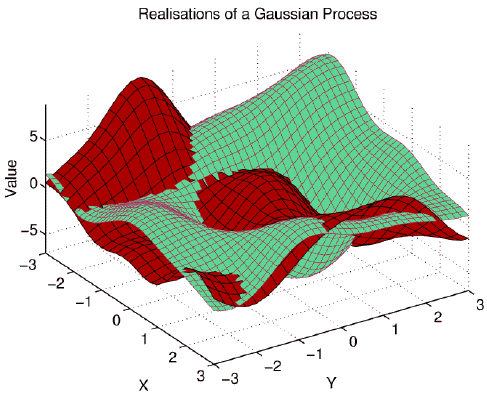Introduction
Gaussian processes are becoming a popular machine learning method.
GPs are non-parametric, which means that the actual number of
"parameters" required scale (at least) linearly with the number of
inputs being processed. In spite of this inconvenient feature, the
flexibility and transparency of the modelling makes it an attractive
method being intensively studied.
The main advantage of the GP inference is its nonparametric nature,
i.e. we do not need a parametric model or function class that
approximates the data but instead we give a non-parametric
specification of the function class which is much richer.
Choosing an RBF
kernel function
for the GP, one can compare the GP regression with regression using
Radial basis functions (RBF). The difference is that for the RBF one
has to specify the locations, in GP these are determined by the data
(similarly to Support Vector Machines). The images below show
realisations of prior GPs in one and two dimensions. Although there are
local minima and maxima, no "centres" can be identified.


Too much freedom in choosing the interpolating function, or excessive
richness of the function class might lead to overfitting - in GP
inference this is avoided by the integration of the extra parameters.
This is made possible by the framework of
Bayesian inference.
Analytic tractability when using Gaussian Processes is restricted to
normal noise or, equivalently, Gaussian
likelihood function, for other
likelihood models one has to use approximations.
Two successive approximations are employed in the GP
inference presented here. A first one iteratively approximates the
non-tractable posterior process with a GP (the origin of the
online word in the title) and a second step
which further simplifies the result by projecting it into a sparse
support (the origin of the sparse
term).
The result of the two approximation steps is a
representation
of the GP which relies only on a few selected input examples, the
so-called
Basis vectors.
Since the approximation to the posterior is Gaussian, one can also
optimise the hyper-parameters of the GP.
Inference in this framework is the inclusion of the input data (the
training set) into the posterior process. This is done by assuming
that we know the
likelihood of
the data and then by applying Bayes' rule one readily gets the
posterior.
The picture below shows a one-dimensional example of the Bayesian
inference, displaying the posterior mean function and possible samples
from the posterior process (more in the
Examples section).

Questions, comments, suggestions: contact Lehel
Csató.




